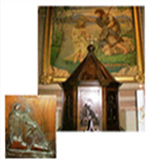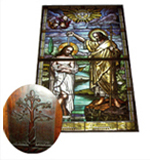Among the many works worthy of note that our beautiful parish church guards , surely the baptismal font and ' one of the most ' important , and maybe we've looked at so many times without knowing anything more ' , then take advantage of this opportunity to deepen the change argument . First of all it must be said that in mind the origin source was not in the position in which the vediamooggi : the side chapels of the church are in fact the result of an expansion performed in the Baroque era , in the seventeenth century. Originally the source was then positioned more ' near the entrance , we can identify such a position at precisely the fresco depicting the baptism of Christ, which is located in the vicinity' holy water : we can assume this fresco at the beginning of 600 , and the ' expansion in the second half' of 600 ( some chapels , dated about 1670 , and the Cathedral of St. Bernard , in Saluzzo , have strong similarities with the stucco decoration of the altars Rossanesi ) .
With the creation of the side chapels and 'thus created a space for the function baptismal much more' broad and circumscribed by railing, even though for decades baptisms are administered to the main altar in front of the entire congregation during the mass. That said, the source, in the form of so-called goblet in gray stone, and 'valuable work of the Brothers Zabreri. These sculptors, originating in the Maira Valley, have been very active in our area in the second half 'of the fifteenth century, and have left several testimonies: for Pravachol, the baptismal fonts of the Parish of Valgrana, Celle Macra, Manta, Revello, Isasca, Brossasco ........
In the stem of the glass and the top edge we see carved in Gothic characters, in Latin, the beginning of the Creed. and the Ave Maria. It 'also the name of the buyer Cabastianus De Mondellis, and the year 1473. It 's not so frequent the newsstand top instead of wood, which contains the baptismal font: personally I was always struck by the stark contrast between the elegance and the attention of the execution of the wooden structure, and simplicity' to say the coarseness of the sculptures of the wooden panels, definitely in style 'naive'! It 'difficult explanation, perhaps a local amateur artist wanted to donate his work, then mounted to a cabinet-maker ... but this certainly enhances contrast the charm of the piece. Then I think it's worth sottolinere the octagonal shape of the source, so often found in ancient sources as well as in buildings adjacent baptistery of the churches (eg in Florence or Parma).
This decision is subject to a theological motive in mind: St. Augustine reminds us that in fact the number 8 symbolizes the eighth day, that 'on Sunday (for the Jews the week ended on Saturday!), The day in which Jesus' risoge and redeems us from our sins. Here then explained the presence of the number 8 when it comes to baptism, and that 'only possible because Christ has redeemed us with His resurrection. Unfortunately this data today and 'unknown to most', and I always regret when I see a font no modern octagonal shape, but maybe round.
Biba Bonardi Albonico,
Guida turistica
Our Baptistery




